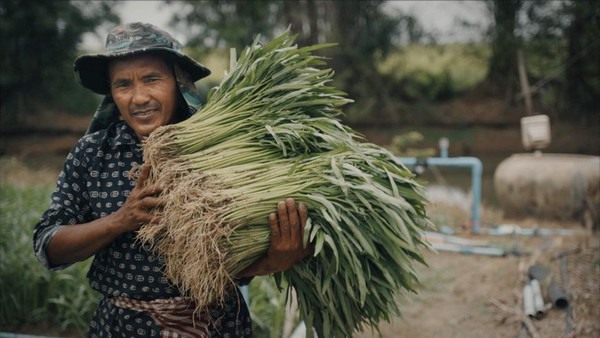They say a farmer's work starts before dawn, but in Cambodia’s Battambang province, farmers work together late into the night to prepare their vegetable harvest for the overnight bus ride to the capital city’s markets.

Photo by Max Fannin
A metal barn that was empty hours ago is now filled with colorful crates, buckets and bags of fresh produce — leafy greens, nubby roots and heads of cabbage — and neighbors bustling to fill boxes. This is a vegetable packinghouse, where members of the Tasey Samaki Agricultural Cooperative collectively market their horticultural crops to wholesale distributors and specialty retail stores.
These small-scale farmers have been working with researchers from the University of California, Davis, and Cambodia’s Royal University of Agriculture (RUA) to test new methods, like the packinghouse, for growing and selling produce locally. Their work is part of the Feed the Future Innovation Lab for Horticulture, a global network focused on fruit and vegetable research that is led by UC Davis and funded by the U.S. Agency for International Development.
“The impact of these innovations in Cambodia has been huge,” said Karen LeGrand, a UC Davis researcher whose work focuses on food safety and security. “Since we started working here 10 years ago, we’ve seen such a change in the food system.”
These innovations are helping farmers benefit from growing and selling horticultural crops, amid rising recognition that fruits and vegetables are not only critical to meet human nutrition needs, but can help farmers in developing countries lift themselves out of poverty.
A creative solution for growing high-quality vegetables
More than 75 percent of Cambodians live in rural areas, and agriculture accounts for about a quarter of gross domestic product. Even so, the country currently imports more vegetables than it harvests.
“After the Khmer Rouge, the main farming focused only on rice,” said Borarin Buntong, director of RUA’s Division of Research and Extension. “But now people are not just thinking about rice anymore. They're thinking about vegetables, they're thinking about fruit. Many families now can have this kind of produce in their daily life. This is a big change for Cambodia.”
Converting rice fields into vegetable fields has allowed farmers to diversify their operations with high-value crops. Studies have shown that profits from vegetables can be 3-14 times higher per hectare than from growing rice.
To strengthen vegetable supply chains, the international researchers introduced farmers to using nets to protect their crops from pests. The idea came from Horticulture Innovation Lab researchers and French CIRAD scientists working in Kenya, where farmers use mosquito nets to cover vegetable plants. In Cambodia, the concept transformed into “nethouses” so farmers could walk inside to care for their crops. The nethouses reduce the need for costly pesticides and protect crops from torrential rain, allowing farmers to grow vegetables year-round, even in the rainy season.
Click here to read the full press release.
For more information:
Amy Quinton
UC Davis
Tel: +1 530 752 9843
Email: amquinton@ucdavis.edu
